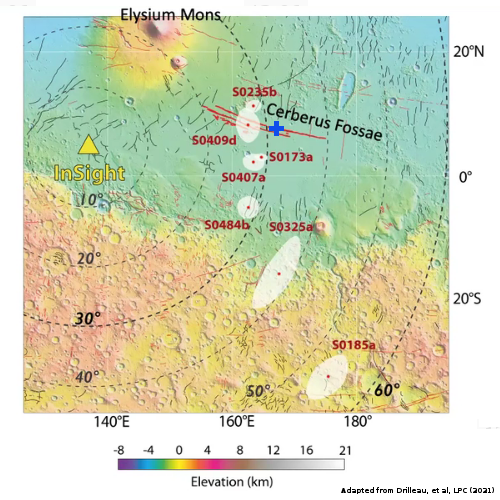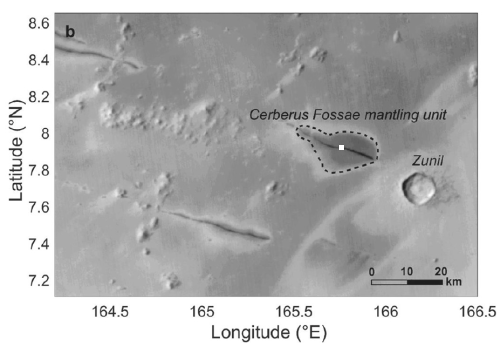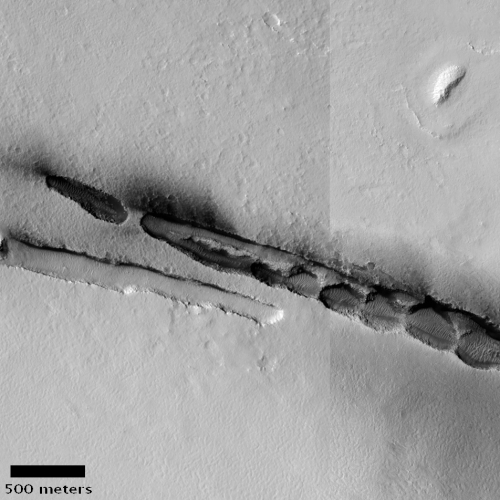Martian volcanic eruption thought to be only 50,000-210,000 years old

Using Mars Reconnaissance Orbiter (MRO) images scientists now believe they have located a volcanic eruption on Mars that could have erupted violently as recently as only 50,000 years ago, and is located deep within Mars’ volcano country. The overview map to the right indicates the location of this volcanic with the blue cross. The red dots surrounded by white ovals are distinct quakes that InSight has detected. From their paper’s abstract:
Stratigraphic relationships indicate a relative age younger than the surrounding volcanic plains and the [nearby] Zunil impact crater (~0.1–1 [million years]), with crater counting suggesting that the deposit has an absolute model age of 53 ± 7 to 210 ± 12 [thousand years]. This young age implies that if this deposit is volcanic then the Cerberus Fossae region may not be extinct and that Mars may still be volcanically active. This interpretation is consistent with the identification of seismicity in this region by the [InSight] lander, and has additional implications for astrobiology.
The Cerberus Fossae region is a series of long fissures that scientists think were created when the underground magma pushed up, stretched the surface, and thus caused it to crack. This particular feature suggests that when the ground cracked it sometimes also did so in conjunction with a volcanic eruption.
Below is a zoomed-in context mosaic, taken from figure 1 of the above paper, showing the feature itself and the surrounding terrain.

This volcanic feature is apparently an 18-mile-long fissure from which spewed material that now darkens the ground to the north and south. After careful comparison of this symmetrical dark feature with other dark wind-caused streaks in this region, the scientists concluded that it was not caused by wind, but is the remains of a relatively recent volcanic eruption that laid down a thin layer of material only about one foot thick. As noted by lead author David Horvath of the Planetary Science Institute in the press release:
“This feature is a mysterious dark deposit, covering an area slightly larger than Washington D.C. It has a high thermal inertia, includes high‑calcium pyroxene-rich material, and is distributed symmetrically around a segment of the Cerberus Fossae fissure system in Elysium Planitia, atypical of aeolian, or wind-driven, deposits in the region. This feature is similar to dark spots on the Moon and Mercury suggested to be explosive volcanic eruptions,” Horvath said. “This may be the youngest volcanic deposit yet documented on Mars. If we were to compress Mars geologic history into a single day, this would have occurred in the very last second.”

Original images found here and here.
The second image to the right, created from two MRO high resolution photos, shows the center point of this volcanic fissure with its location indicated by the white dot in figure one above. The circular features are only found in this part of the fissure, where there is also less of the surrounding dark mantle. Their circular shape suggests to my uneducated mind that they might be the launch points for individual eruptive events, but that is a pure guess.
If the scientists’ hypothesis is correct, this volcanic feature is significantly younger than what has previously been thought to be the youngest volcanic feature on Mars, the Athabasca flood plain, which is thought to have occurred in a period of only a few weeks about 600 million years ago out of nearby other cracks in Cerberus Fossae. As Horvath explained to me, “It seems that young volcanism in this region effectively utilized the Cerberus fissure system as a conduit to reach the surface.”
More important, that this feature might be only 50,000 years old and is also located in the same region InSight has detected quake activity suggests that Mars might still have some active volcanism. It suggests that we might someday even see an eruption actually occur.
On Christmas Eve 1968 three Americans became the first humans to visit another world. What they did to celebrate was unexpected and profound, and will be remembered throughout all human history. Genesis: the Story of Apollo 8, Robert Zimmerman's classic history of humanity's first journey to another world, tells that story, and it is now available as both an ebook and an audiobook, both with a foreword by Valerie Anders and a new introduction by Robert Zimmerman.
The print edition can be purchased at Amazon or from any other book seller. If you want an autographed copy the price is $60 for the hardback and $45 for the paperback, plus $8 shipping for each. Go here for purchasing details. The ebook is available everywhere for $5.99 (before discount) at amazon, or direct from my ebook publisher, ebookit. If you buy it from ebookit you don't support the big tech companies and the author gets a bigger cut much sooner.
The audiobook is also available at all these vendors, and is also free with a 30-day trial membership to Audible.
"Not simply about one mission, [Genesis] is also the history of America's quest for the moon... Zimmerman has done a masterful job of tying disparate events together into a solid account of one of America's greatest human triumphs."--San Antonio Express-News

Using Mars Reconnaissance Orbiter (MRO) images scientists now believe they have located a volcanic eruption on Mars that could have erupted violently as recently as only 50,000 years ago, and is located deep within Mars’ volcano country. The overview map to the right indicates the location of this volcanic with the blue cross. The red dots surrounded by white ovals are distinct quakes that InSight has detected. From their paper’s abstract:
Stratigraphic relationships indicate a relative age younger than the surrounding volcanic plains and the [nearby] Zunil impact crater (~0.1–1 [million years]), with crater counting suggesting that the deposit has an absolute model age of 53 ± 7 to 210 ± 12 [thousand years]. This young age implies that if this deposit is volcanic then the Cerberus Fossae region may not be extinct and that Mars may still be volcanically active. This interpretation is consistent with the identification of seismicity in this region by the [InSight] lander, and has additional implications for astrobiology.
The Cerberus Fossae region is a series of long fissures that scientists think were created when the underground magma pushed up, stretched the surface, and thus caused it to crack. This particular feature suggests that when the ground cracked it sometimes also did so in conjunction with a volcanic eruption.
Below is a zoomed-in context mosaic, taken from figure 1 of the above paper, showing the feature itself and the surrounding terrain.

This volcanic feature is apparently an 18-mile-long fissure from which spewed material that now darkens the ground to the north and south. After careful comparison of this symmetrical dark feature with other dark wind-caused streaks in this region, the scientists concluded that it was not caused by wind, but is the remains of a relatively recent volcanic eruption that laid down a thin layer of material only about one foot thick. As noted by lead author David Horvath of the Planetary Science Institute in the press release:
“This feature is a mysterious dark deposit, covering an area slightly larger than Washington D.C. It has a high thermal inertia, includes high‑calcium pyroxene-rich material, and is distributed symmetrically around a segment of the Cerberus Fossae fissure system in Elysium Planitia, atypical of aeolian, or wind-driven, deposits in the region. This feature is similar to dark spots on the Moon and Mercury suggested to be explosive volcanic eruptions,” Horvath said. “This may be the youngest volcanic deposit yet documented on Mars. If we were to compress Mars geologic history into a single day, this would have occurred in the very last second.”

Original images found here and here.
The second image to the right, created from two MRO high resolution photos, shows the center point of this volcanic fissure with its location indicated by the white dot in figure one above. The circular features are only found in this part of the fissure, where there is also less of the surrounding dark mantle. Their circular shape suggests to my uneducated mind that they might be the launch points for individual eruptive events, but that is a pure guess.
If the scientists’ hypothesis is correct, this volcanic feature is significantly younger than what has previously been thought to be the youngest volcanic feature on Mars, the Athabasca flood plain, which is thought to have occurred in a period of only a few weeks about 600 million years ago out of nearby other cracks in Cerberus Fossae. As Horvath explained to me, “It seems that young volcanism in this region effectively utilized the Cerberus fissure system as a conduit to reach the surface.”
More important, that this feature might be only 50,000 years old and is also located in the same region InSight has detected quake activity suggests that Mars might still have some active volcanism. It suggests that we might someday even see an eruption actually occur.
On Christmas Eve 1968 three Americans became the first humans to visit another world. What they did to celebrate was unexpected and profound, and will be remembered throughout all human history. Genesis: the Story of Apollo 8, Robert Zimmerman's classic history of humanity's first journey to another world, tells that story, and it is now available as both an ebook and an audiobook, both with a foreword by Valerie Anders and a new introduction by Robert Zimmerman.
The print edition can be purchased at Amazon or from any other book seller. If you want an autographed copy the price is $60 for the hardback and $45 for the paperback, plus $8 shipping for each. Go here for purchasing details. The ebook is available everywhere for $5.99 (before discount) at amazon, or direct from my ebook publisher, ebookit. If you buy it from ebookit you don't support the big tech companies and the author gets a bigger cut much sooner.
The audiobook is also available at all these vendors, and is also free with a 30-day trial membership to Audible.
"Not simply about one mission, [Genesis] is also the history of America's quest for the moon... Zimmerman has done a masterful job of tying disparate events together into a solid account of one of America's greatest human triumphs."--San Antonio Express-News


To witness a volcanic eruption on Mars would quite literally be out of this world. Too bad Insight does not have its own Ingenuity helicopter to check out some of these areas.
Geothermal power anyone? This and low gravity might explain landforms. Maar craters can look like astroblemes.
I’m wishing for an astrobleme for next Christmas!